Preview
The Preview tab’s settings apply to interactive rendering in a given view (ProRender menu in the Viewport.
Note that the preview can deviate greatly from offline rendering due to the reduced settings. This is especially the case for transparent objects (e.g., glass) because the Sample Depth is only set to 3. In such cases you should adjust the corresponding value accordingly for offline rendering.
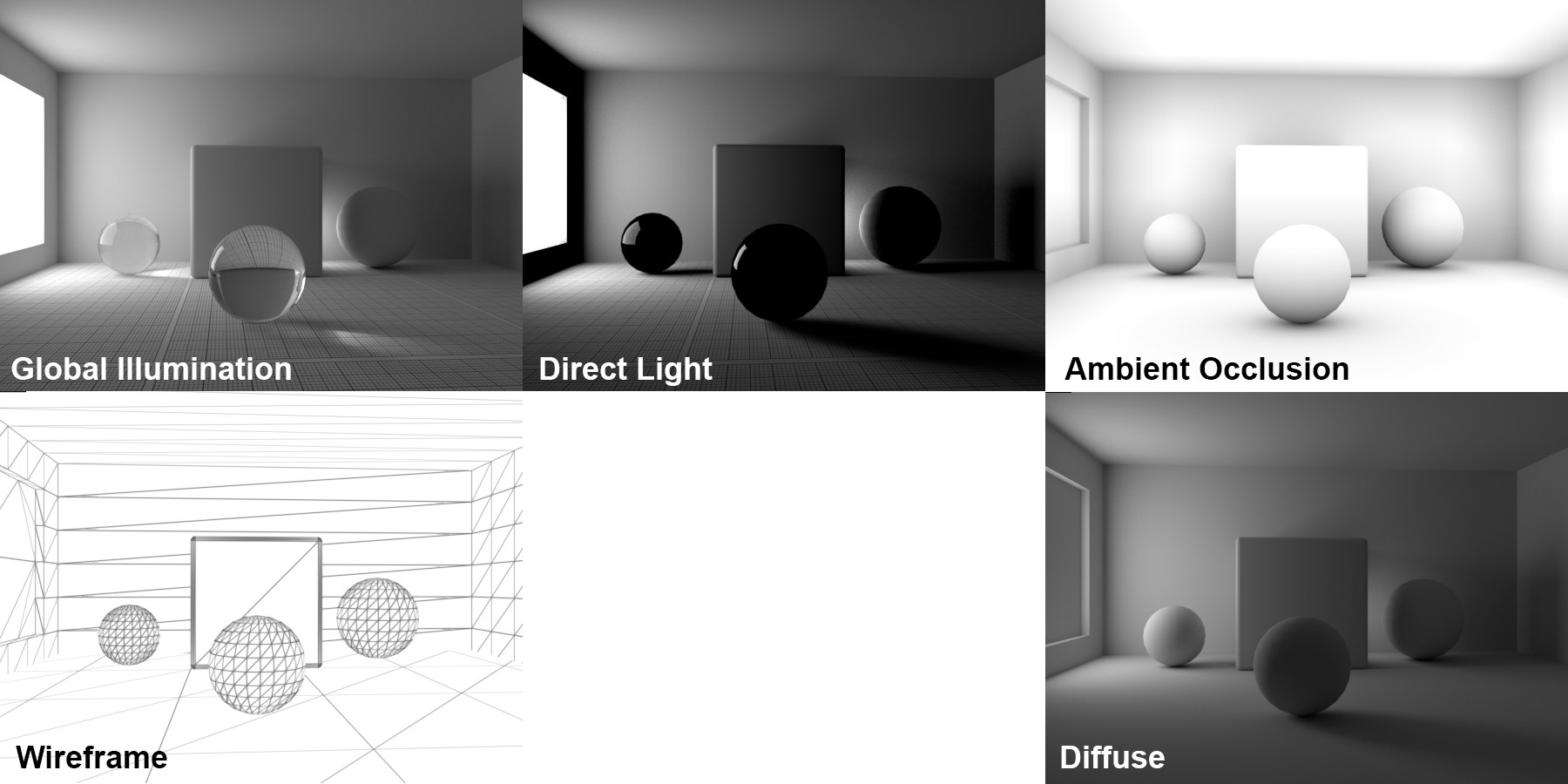 The various render modes.
The various render modes.Here you can define various render modes:
The default and most important render mode. Global Illumination is used for ProRender to create GI, shadows, reflections, refractions in transparencies, i.e., all functions that have to do with samples being sent back and forth or is reflected or refracted.
Ambient Occlusion will be rendered (the more occluded a region the darker; see also Ambient Occlusion).
In this mode, there is no other light that is reflected from other objects - i.e., no GI. Only the direct illumination, including shadows. Reflections (exception: reflections of light sources) and transparencies are also disabled.
This mode renders the triangle edges (quads will be broken down into triangles internally) of the scene geometry gray on a white background. This can be useful, for example, if you want to display the polygon topology.
Sometimes it’s advisable to render only the untextured scene for lighting purposes. This is what this mode is for: it assigns a gray, diffuse material to all objects. The scene renders much faster without textures and the homogenous shading makes it possible to judge how light sources work together with the blank geometry.
Use this option to enable or disable the depth of field (incl. any Bokehs, see also Diaphragm Shape for the Physical Renderer). Note that the renderer will most often be pushed to its limits in its efforts to remove noise. However, the depth of field is a key element for creating a photorealistic look.
General information about this function can be found under Depth Of Field.
During rendering, very many rays are emitted into the scene through each output pixel. Depending on the type of surface a ray hits it will be split: this way it can, for example, be reflected and/ or refracted; for matte or diffuse surfaces, a great number of rays from different angles can be reflected or refracted:
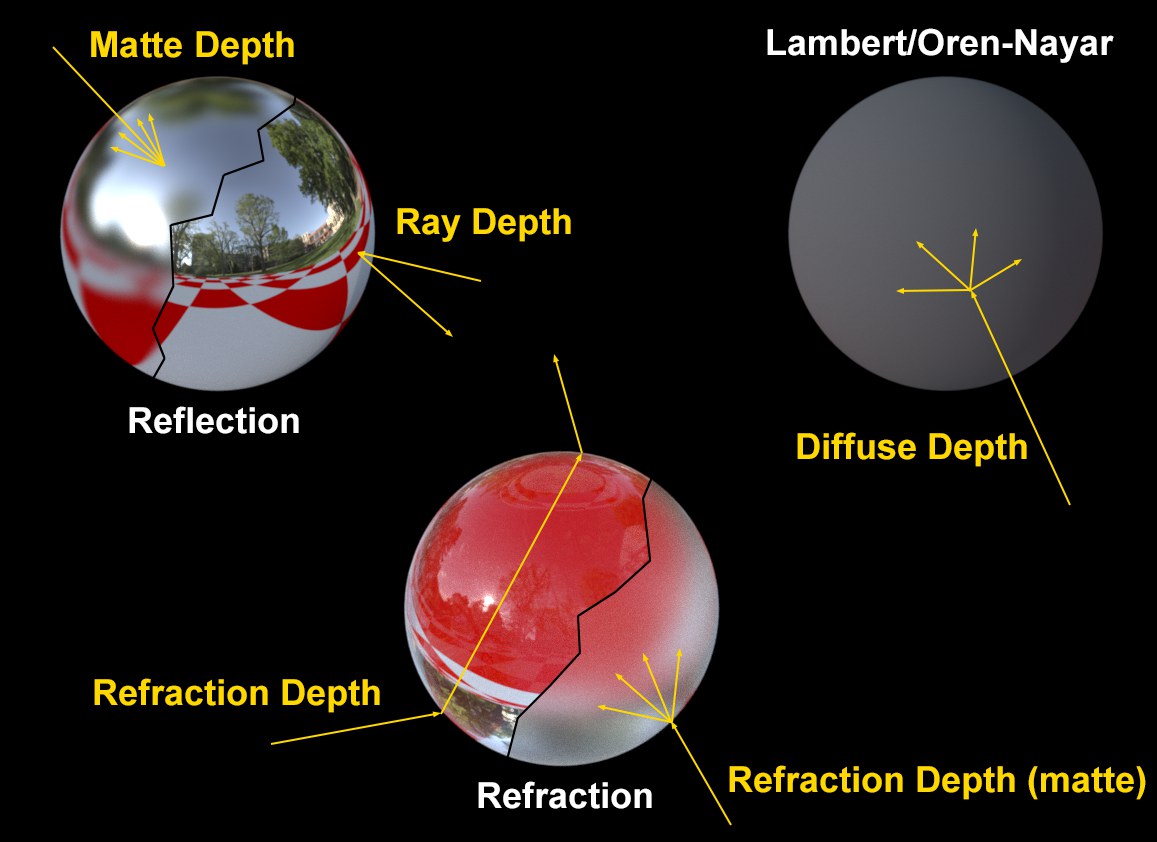 This is how ray types are defined. The depth settings define the number of reflections/ refractions per ray type (exception: Max Ray Depth).
This is how ray types are defined. The depth settings define the number of reflections/ refractions per ray type (exception: Max Ray Depth).Rays pass back-and-forth through the scene millions of times collecting color and brightness information (samples). In the real world, this happens infinitely but in Cinema 4D this has to end at some point, otherwise calculating each pixel would also be an infinite undertaking. Therefore, the number of reflections and refractions has to be limited.
Each of these ray types can be defined separately to optimize render times. The values can be reduced specifically to reduce render times.
Generally speaking, the following can be said: The differences in rendering for values of 1, 2 or 3 are large; the higher the values, the less difference there is between them. This is not surprising since, for example, the 7th reflection of a bright light source is so dark that it barely makes a difference - but still requires render time.
In general, for all depth settings, the larger the value the longer the render time will be. The smaller the shorter. However, with small values - from around 0-3 - artefacting will increase correspondingly.
The Max Ray Depth defines the number of reflections that a ray can take for reflective surfaces (Roughness = 0, i.e., sharp reflections).
It also defines a maximum value fur the following 4 depth settings (even if, for example, Refraction Depth is set to 12, the Max Ray Depth defined here will be valid as long as it’s lower).

Note that caustics can first appear at a Max Ray Depth of 2 or greater.

This setting defines the number of reflections that a ray can accept for a diffuse surface (Lambert, Oren-Nayer). This effect can, in essence, be described as Global Illumination.
The higher the value, the brighter the scene will be. However, with a Diffuse Depth of 4 or higher you will barely notice a difference because the increasing number of reflections will not brighten the overall scene any stronger. If the rendering is too dark, it’s better to work with Tone Mapping instead of constantly increasing the Diffuse Depth value.
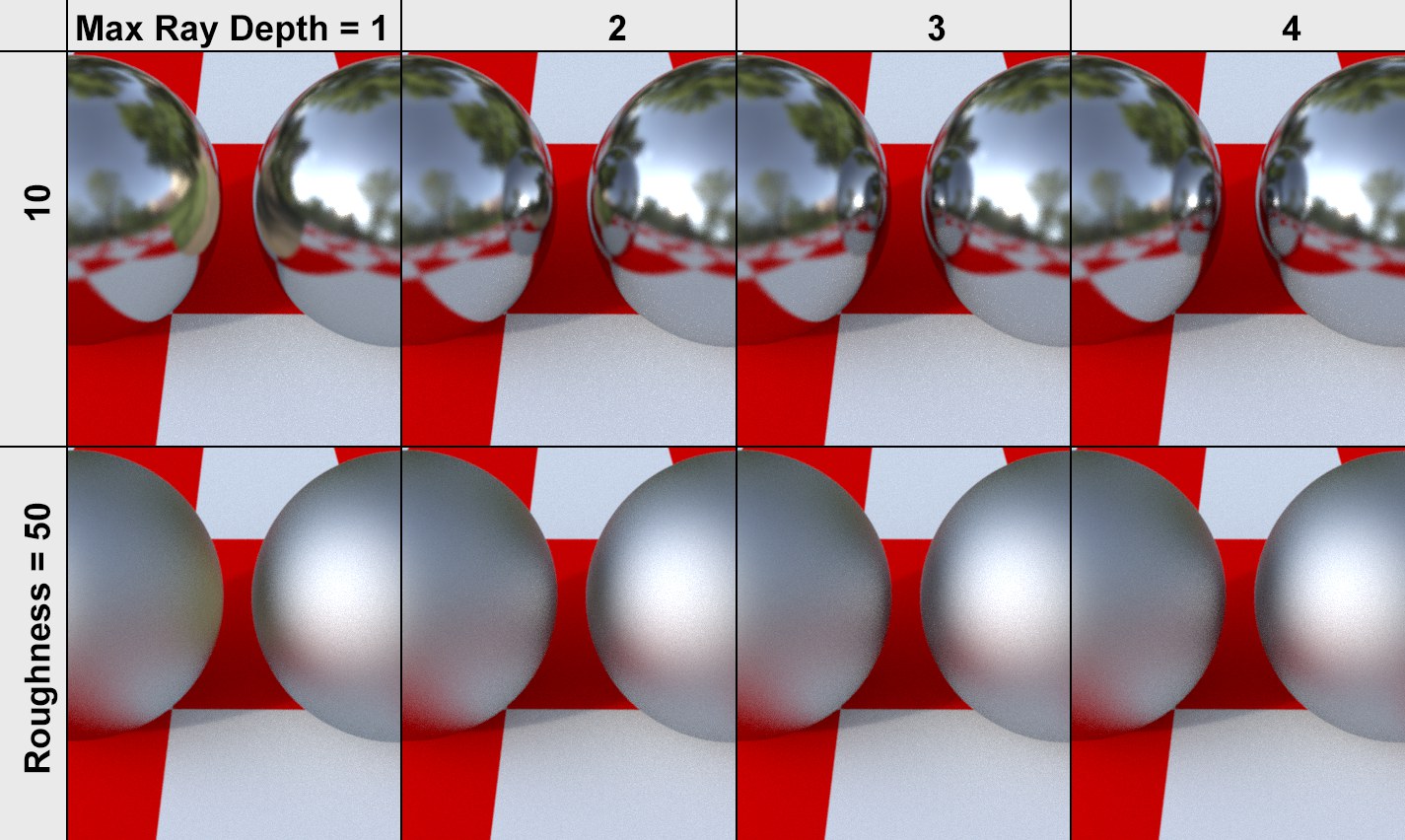
This setting defines the number of reflections a matte reflection (Roughness > 0) can take.
The higher the roughness, the smaller the Max Ray Depth can be, without artefacts being created.
Smaller values result in correspondingly shorter render times (and more iterations).
Refraction Depth [0..2147483647]
 3 transparent layers rendered with different Refraction Depth settings. For voluminous objects (shown here without thickness for demonstration purposes), the Refraction Depth must be doubled to achieve the desired effect.
3 transparent layers rendered with different Refraction Depth settings. For voluminous objects (shown here without thickness for demonstration purposes), the Refraction Depth must be doubled to achieve the desired effect.The Refraction Depth defines the number of refractions allowed for clear, transparent glass. If the value is too low, the ray tracing will be stopped at the color black.
The Refraction Depth also works with Subsurface Scattering (Transparency option enabled) and must have a value of at least 2. However, the depth only applies to the entry and exit from the refracting object (refraction within the object is dependent on this).
Glossy Refraction Depth [0..2147483647]
 3 matte transparent layers rendered with different Refraction Depths. For voluminous objects (shown here without thickness for demonstration purposes), the Refraction Depth must be doubled to achieve the desired effect.
3 matte transparent layers rendered with different Refraction Depths. For voluminous objects (shown here without thickness for demonstration purposes), the Refraction Depth must be doubled to achieve the desired effect.The Refraction Depth (Depth) defines the number of refractions allowed for matte glass. If the value is too low, the ray tracing will end at the color black.
The Refraction Depth also works with Subsurface Scattering (Transparency option disabled) and must have a value of at least 2. However, the depth only applies to the entry and exit from the refracting object (refraction within the object is dependent on this).
This setting affects transparent materials or those with alpha channels assigned to them: to calculate shadows, ProRender emits shadow rays to the light sources (for all light-reflecting objects) for each visible surface. Refraction Depth is used for each transparent / alpha material that lies between the surface and a light source:
 Different Shadow Depth values and the rendered results with various transparencies.
Different Shadow Depth values and the rendered results with various transparencies.This setting defines the number of transparencies/alphas that the shadow ray should take into account on its way to the light source.
Note that refracting transparencies (i.e., Refraction not equal to 1) are not included in the shadow rays (this is what refraction rays, which can create caustics, are for).
For voluminous objects, both the front and back sides are each seen as a transparency.
Ambient Occlusion Ray Length [0.001..+∞m]
 Increasing Ambient Occlusion Ray Length values from left to right.
Increasing Ambient Occlusion Ray Length values from left to right.Use this value to define the distance at which surfaces can "see" each other and thus be darkened. Smaller values will only color regions in close proximity of touching surfaces and larger values will produce an effect similar to that of diffused lighting.
During rendering, the scene - from the camera’s angle of view - is divided into a grid (= output resolution) consisting of pixels. For each pixel and each iteration, a number of samples (Samples per Iteration) are shot into the scene. To prevent stepping at edges from occurring (imagine the angled edge of a cube that runs through the grid, see also How antialiasing works (for the Standard Renderer)), the samples will be dispersed across the entire pixel surface and the samples gathered per pixel combined (= pixel color).
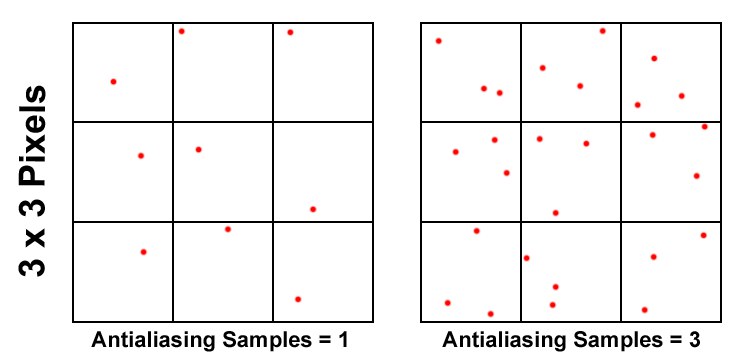 An example of a sample dispersion of a 3x3 pixel rendering per iteration.
An example of a sample dispersion of a 3x3 pixel rendering per iteration.This setting can be used to define the sample count per iteration:
This setting has no impact for longer renderings: the result will be the same.
What is this setting good for? You can use it to affect the jumps in quality between iterations in addition to the iteration length in the Picture Viewer - many Samples per Iteration produce a greater difference between iterations, whereby each iteration will take longer, and vice-versa.
Whether you have a low number of iterations and many samples or a hight number of iterations with few samples, basically the same render quality will be achieved with pretty much equal render times.
If you ignore the filters described in the next section, all of a pixel’s samples will be combined and the pixel will be rendered accordingly.
In the previous section we described how samples are dispersed across a pixel surface. The Filter settings can be used to define how these samples affect each pixel for rendering in the area of Filter Size.
In the example below, a section was enlarged so the filter can be seen more clearly.
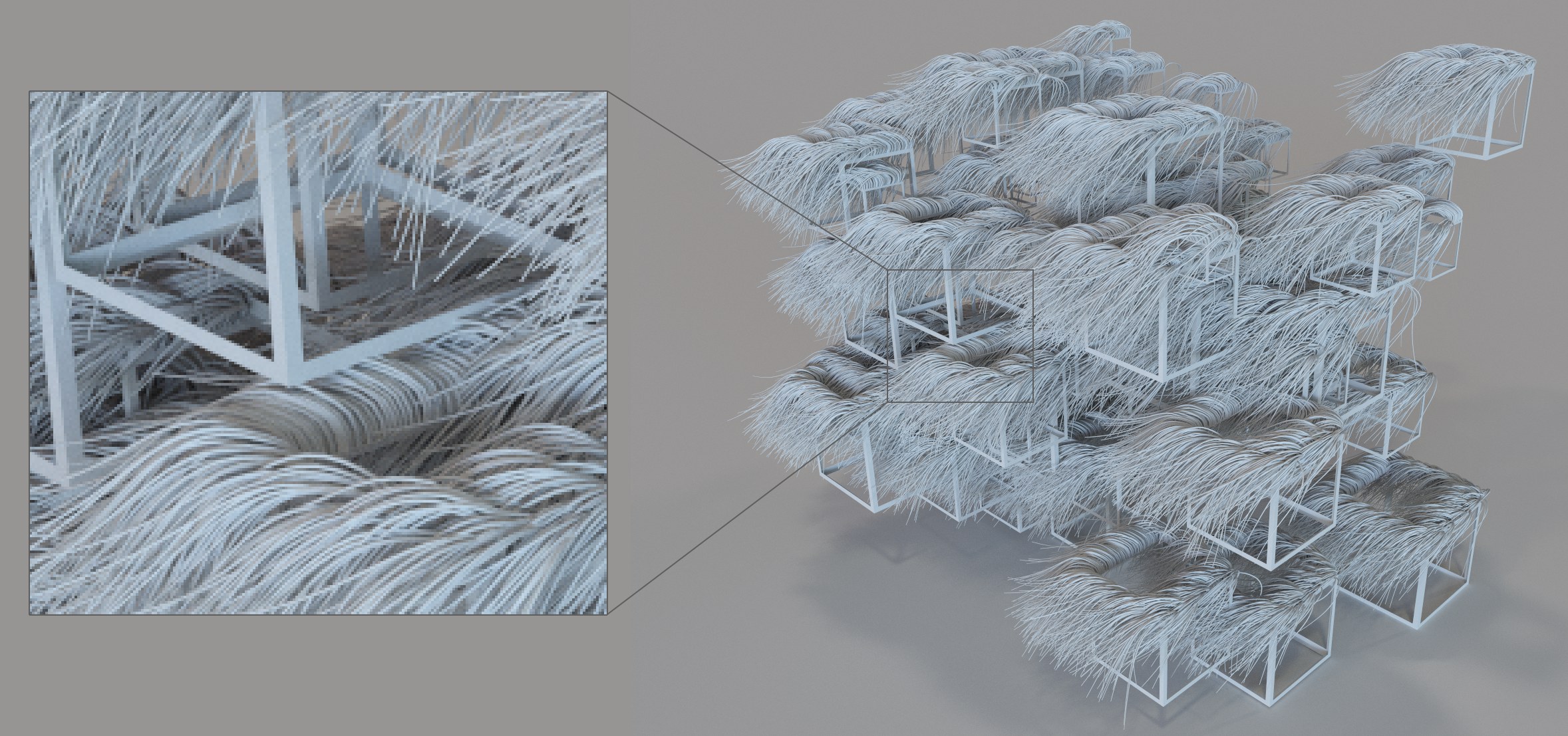
In the example below you can zoom in to see more detail.
 This is how the samples are weighted per pixel color starting from the pixel center (Filter Size 1, 1.5 and 2, respectively).
This is how the samples are weighted per pixel color starting from the pixel center (Filter Size 1, 1.5 and 2, respectively).The filter curves obey different functions for which the X axis is the pixel center and the Y axis is the weighting for each sample.
The Filter Size (in pixels) defines how many neighboring pixel surfaces around the pixel should be used to combine all respective samples. The larger the value, the more blurred details will be. A value of 0.5 will only affect the surface of the current pixel.
Radiance Clamp
Radiance Clamp Value [1..+∞]
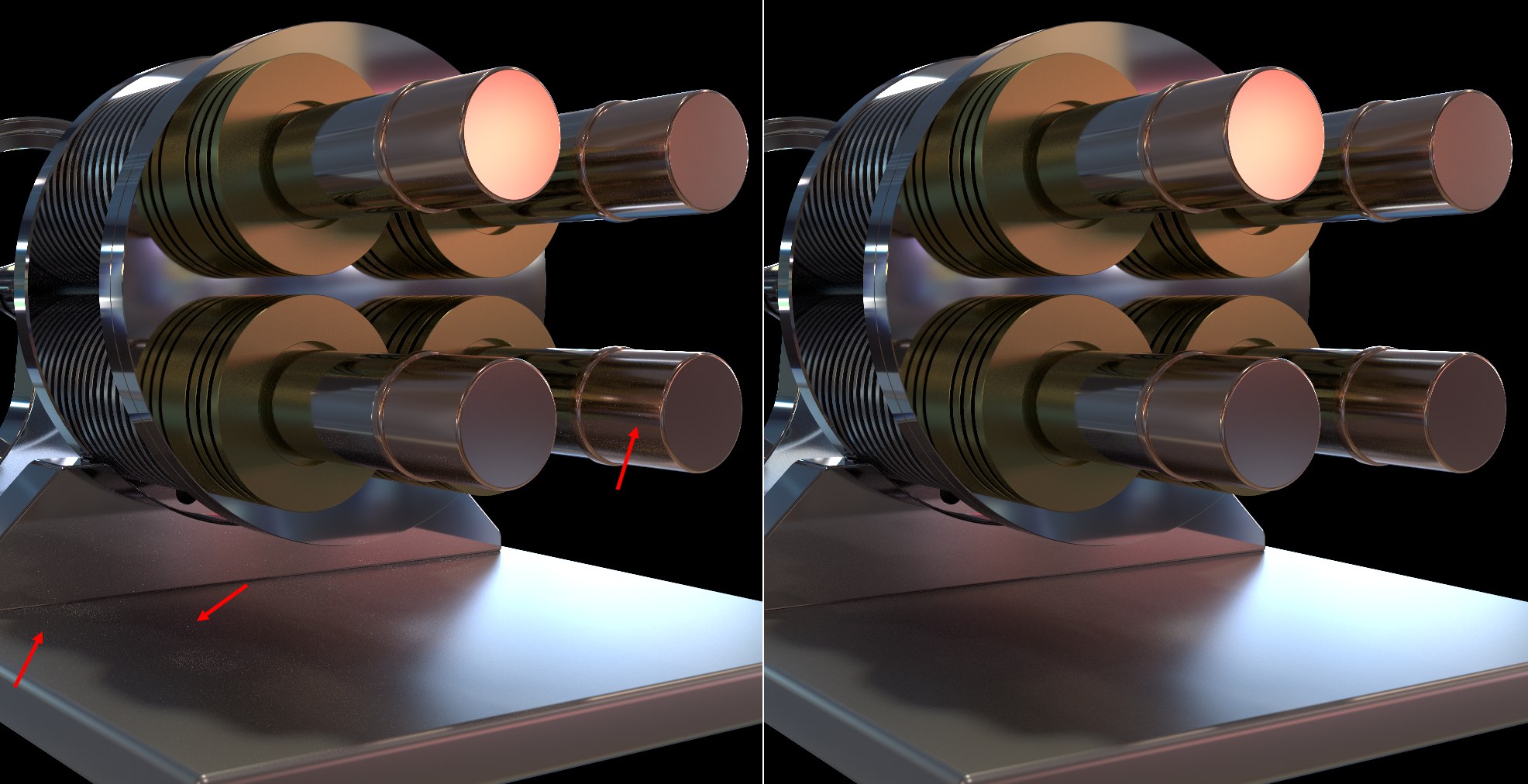 At left without Radiance Clamp, at right with (fireflies and caustics are gone).
At left without Radiance Clamp, at right with (fireflies and caustics are gone).The Radiance Clamp setting can be used to restrict the sample density (or put simply: the brightness) of reflected/refracted samples. The smaller the value, the greater the restriction and larger values will allow correspondingly more brightness. Direct reflections (i.e., a value of 1) are not affected. Crisp HDRI reflections remain unaffected.
This setting can also be used to restrict fireflies (see also Firefly Threshold).
Attention: These settings have a major effect on caustics. Their brightness is reduced. A physically correct rendering is no longer possible. If you look at the image above you will see a hint of caustics on the left, which is not present on the right.
The impact of the sample density setting and the Firefly filter described below is reduced greatly if the Denoisers is applied. The Denoiser filters firefly effects very effectively!
![]() Progressive Rendering
Progressive Rendering
ProRender renders progressively and - if not told to do so - indefinitely. However, since all renderings must come to an end, these options can be used to define how this should be done:
- Iteration Count: Rendering will end when the defined number of samples per pixel has been reached.
- Time Limit (s): Rendering will end after the defined period of time.
- Threshold: The noise in the rendering will be "measured" and if the defined Threshold value is exceeded (see below), the rendering will end (this option is not available for the preview).
- Never: Rendering will never end (this option should never be used to render animations.
Iteration Count [1..2147483647]
First, an explanation of the meaning of Iterations for ProRender.
An iteration means that the renderer has calculated each pixel once - or if antialiasing is disabled, a sample has been gathered for each pixel. Higher antlialiasing settings means that correspondingly more samples will be gathered per pixel for each iteration. The larger the image and more complex the scene (e.g., numerous reflections and refractions), the fewer iterations a graphics card can complete within the same frame of time (the current number of iterations is continuously displayed in the Picture Viewer’s status bar).
For example, if the quality of your rendering is satisfactory with an Iteration Count of 1,000, this value can be entered here so the animation is rendered in the corresponding quality.
Time Limit (s) [0..2147483647]
Enter the time in seconds that the renderer should render per frame. Note that this time should not be seen as absolute because the renderer still has to fully complete an iteration before continuing to the next frame or before it stops rendering. In reality, slightly more time per frame or image will be required.
![]() Preview Resolution
Preview Resolution
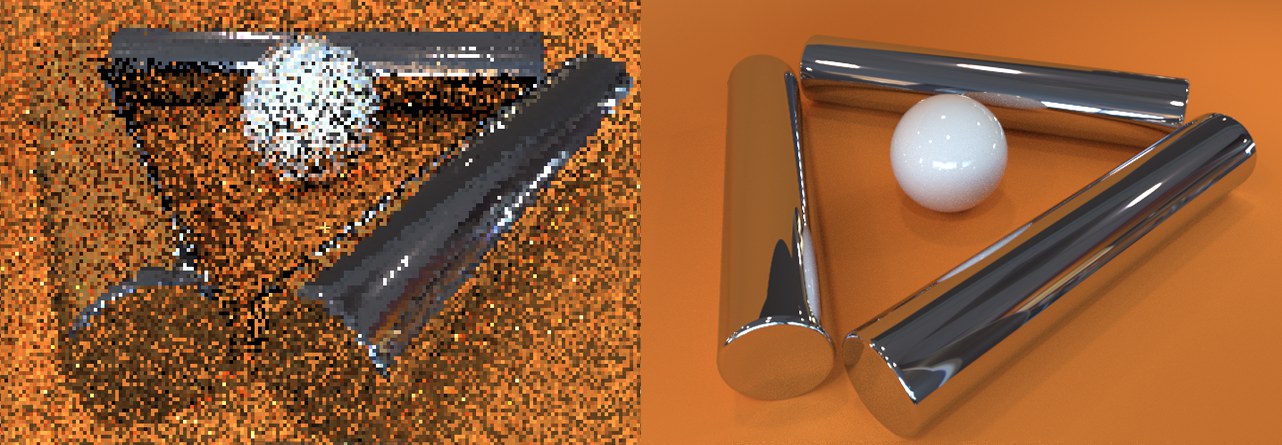 Left: example depiction during navigation; right: well after the camera stopped moving.
Left: example depiction during navigation; right: well after the camera stopped moving.When using ProRender as for previews, settings can be defined here that will speed up navigation. The Viewport will briefly switch to a lower resolution (as wel as for other relevant changes made to the scene).
When navigating in the preview, a small and faster resolution will initially be used. When the camera stands still the resolution defined here will be used briefly. Flickering during navigation has been greatly reduced, which makes a much more fluid display possible.
![]() Default Texture Resolution
Default Texture Resolution
ProRender currently has the limitation that not all shaders can be rendered natively on the graphics card (see also Limitations). These shaders must be converted to bitmaps that can then be read by the graphics card. This is why you can define the texture size for respective shaders globally (note that the texture size can be defined at shader level in the Basic menu).
All shaders will be converted to bitmaps before rendering starts, which can take quite some time.
 A small texture on the left (128*128) and a large texture on the right (1280*1280).
A small texture on the left (128*128) and a large texture on the right (1280*1280). Texture Size X [1..8192]
Texture Size Y [1..8192]
Enter the texture size in pixels here. Remember that the graphics card’s memory is limited and some will simply crash if too much memory is required.
Here you can select between 8-bit and 32-bit (in case you use shaders with color values that exceed 8 bits).